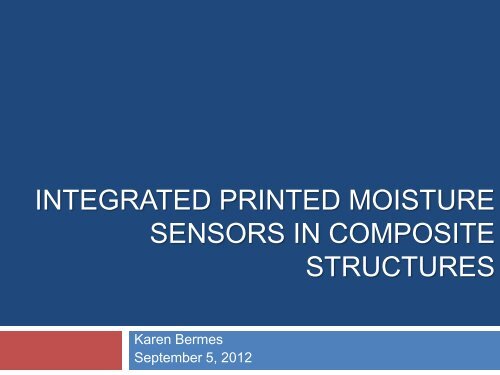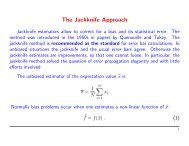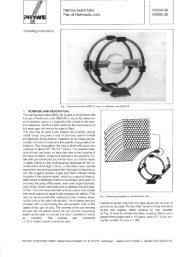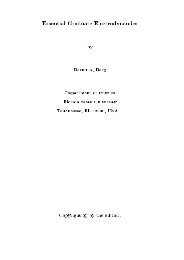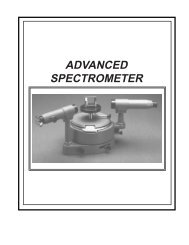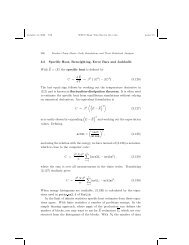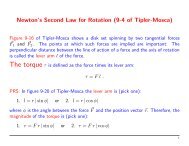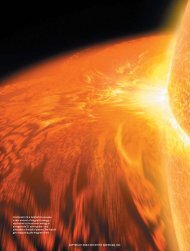Integrated Printed Moisture Sensors in Composite Structures (pdf).
Integrated Printed Moisture Sensors in Composite Structures (pdf).
Integrated Printed Moisture Sensors in Composite Structures (pdf).
Create successful ePaper yourself
Turn your PDF publications into a flip-book with our unique Google optimized e-Paper software.
INTEGRATED PRINTED MOISTURE<br />
SENSORS IN COMPOSITE<br />
STRUCTURES<br />
Karen Bermes<br />
September 5, 2012
Clarification<br />
• <strong>Integrated</strong> sensor<br />
• Inside composite structures<br />
• <strong>Pr<strong>in</strong>ted</strong> electronics<br />
• Pr<strong>in</strong>ts conductive <strong>in</strong>ks to form circuit
High Performance Materials Institute<br />
“Improve the performance and affordability of<br />
advanced composite materials and structures.” [1]<br />
Multifunctional composite structure<br />
•Prosthetics<br />
•Thermal management<br />
•EMI shield<strong>in</strong>g<br />
Images retrieved from [1]
Why do we need moisture sensors?<br />
Boe<strong>in</strong>g 787<br />
• Comprised 50% by weight<br />
• <strong>Moisture</strong> can permeate through structure<br />
• Integrate sensor <strong>in</strong>to structure for detection<br />
o Th<strong>in</strong><br />
Retrieved from [2]
Fiber Optic <strong>Moisture</strong> Sensor<br />
• Index of refraction<br />
• Acts as a defect along path<br />
• Convert<strong>in</strong>g light to electrical signal can be<br />
expensive<br />
US Patent No. 4,221,962
Technology<br />
• Nanotechnology<br />
• Buckypaper<br />
• <strong>Pr<strong>in</strong>ted</strong> Electronics<br />
• OPTOMEC M 3 D Pr<strong>in</strong>ter<br />
• Controlled Environment Chamber<br />
• Vary humidity
Buckypaper (BP)<br />
• 250x stronger and 10x lighter<br />
than steel [1]<br />
• Electrically conductive<br />
• 25 μm thick<br />
• Randomly aligned carbon<br />
nanotubes (CNTs)<br />
• SW and MW<br />
• Large surface area<br />
Retrieved from [1]<br />
Retrieved from [3]
OPTPMEC M 3 D Pr<strong>in</strong>ter
Controlled Environment Chamber
Procedure<br />
• <strong>Pr<strong>in</strong>ted</strong> open circuit on polyimide<br />
• S<strong>in</strong>ter<br />
• Attach BP or pr<strong>in</strong>t CNT <strong>in</strong>k<br />
• Attach measurement materials/<strong>in</strong>struments<br />
• Silver paste<br />
• Gold and copper wire<br />
• Measure resistance <strong>in</strong> CEC while vary<strong>in</strong>g humidity
Parameters<br />
• Spac<strong>in</strong>g between silver electrodes<br />
• Pr<strong>in</strong>t<strong>in</strong>g multiple passes<br />
• Dry samples before test<strong>in</strong>g
Prediction<br />
• CNTs are electrically conductive<br />
• Pure water<br />
• Resistance will <strong>in</strong>crease with <strong>in</strong>creas<strong>in</strong>g<br />
humidity
Buckypaper Sensor
Resistance Ω<br />
Resistance vs. Relative Humidity BP<br />
9.1<br />
200μm NC BP Sensor<br />
9.05<br />
9<br />
8.95<br />
Decreas<strong>in</strong>g<br />
Increas<strong>in</strong>g<br />
8.9<br />
8.85<br />
8.8<br />
10 20 30 40 50 60 70 80 90 100<br />
% Relative Humidity
Resistance Ω<br />
Resistance vs. Relative Humidity BP<br />
9.25<br />
100μm NC BP Sensor<br />
9.2<br />
9.15<br />
9.1<br />
9.05<br />
Decreas<strong>in</strong>g<br />
Increas<strong>in</strong>g<br />
9<br />
8.95<br />
8.9<br />
0 20 40 60 80 100<br />
% Relative Humidity
Resistance Ω<br />
Resistance vs. RH Dried BP<br />
2.26<br />
Dried BP 200μm<br />
2.25<br />
2.24<br />
2.23<br />
2.22<br />
2.21<br />
2.2<br />
2.19<br />
2.18<br />
0 20 40 60 80 100<br />
% Relative Humidity
CNT <strong>Pr<strong>in</strong>ted</strong> Sensor
Resistance Ω<br />
Resistance vs. Relative Humidity CNT<br />
21000<br />
<strong>Pr<strong>in</strong>ted</strong> CNT Sensor 1<br />
20500<br />
20000<br />
19500<br />
19000<br />
18500<br />
18000<br />
Decreas<strong>in</strong>g<br />
Increas<strong>in</strong>g<br />
17500<br />
17000<br />
16500<br />
16000<br />
0 20 40 60 80 100<br />
% Relative Humidity
Hysteresis<br />
• Nonl<strong>in</strong>ear, cyclic reaction<br />
• The current state of a system is dependent on<br />
its past state, but nondependent on rate [4]<br />
• The goal is to develop a sensor with no<br />
hysteretic response.
Future Research Plans<br />
• Embed sensor <strong>in</strong>to composite structure<br />
• Test effect on structural <strong>in</strong>tegrity<br />
• Identify physical properties that cause different<br />
responses to changes <strong>in</strong> humidity<br />
• Improve design to avoid hysteretic responses
References<br />
[1] http://www.hpmi.net<br />
[2] http://www.boe<strong>in</strong>g.com<br />
[3] http://www-ibmc.u-strasbg.fr<br />
[4] Cruz-Hernandez JM and Hayward V 2001<br />
“Phase control approach to hysteresis<br />
reduction” Control Systems Technology, IEEE<br />
Transactions on 9(1) 17-26
Thank you<br />
Questions?


